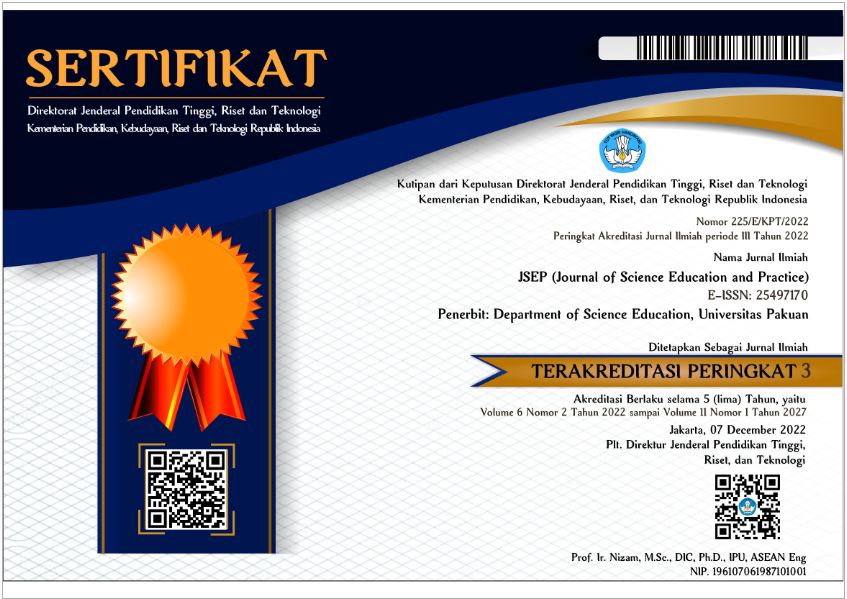ADDITIONAL MENU
The Applicaton of Flipped Classroom Learning Model of High School Students on Electrolyte and Non-Electrolyte Solutions
Abstract
Keywords
References
Bergmann, J., & Sams, A. (2012). Flip Your Classroom Reach Every Student in Every Class Every Day (Frist Edit). International Society for Technology in Education.
Chandra, FH, & Nugroho, YW (2017). Implementation of Flipped Classroom with Video Tutorials on Commercial Photography Learning. Visual Communication Design, Design And Advertising Management, 2036.
Damayanti, HN, & Sutama. (2016). The Effectiveness of Flipped Classroom on Attitudes and Learning Skills in Mathematics in Vocational High Schools. Education Management, 11, 17. http://journals.ums.ac.id/index.php/jmp/article/view/1799/1251
Djajalaksana, Y., Adelia, & Zener, E. (2014). Application of the Flipped Classroom Concept for Statistics and Probability Courses in the Information Systems Study Program.
Hamalik. (2008). Teaching and learning process. Earth Literature.
Johnson, GB (2013). Student Perceptions of The Flipped Classroom. University of British Columbia.
Nugroho, HI (2015). Increasing Motivation and Mathematics Learning Outcomes with Flipped Classroom Learning Strategies. at Muhammadiyah University of Surakarta. Muhammadiyah Surakarta.
Paristiowati, M., Cahyana, U., & Fitria, AN (2017). Flipped Classroom: Alternative of The Model of Learning to Improve Student Learning Outcomes in K-10. IJER, 4(1), 148152. http://journal.unj.ac.id/unj/index.php/ijer
Paristiowati, M., Fitriani, E., & Aldi, NH (2017). The Effect of Inquiry-Flipped Classroom Model Toward Students' Achievement on Chemical Reaction Rate. AIP Conference Proceedings, 1868. https://doi.org/10.1063/1.4995105
Indonesian government. (2003). Law of the Republic of Indonesia Number 20 of 2003 concerning the National Education System.
Riduwan. (2010). Basic Statistics. Alphabet.
Roehl, AMY, Reddy, SL, & Shannon, GJ (2013). The Flipped Classroom : An Opportunity To Engage Millennial Students Through Active Learning Strategies. Family & Consumer Sciences, 105(2), 4449.
Santoso, A. (2010). Effect Size Researches at the Faculty of Psychology, Sanata Dharma University. Research Journal, 14(1).
Sugiyono. (2010). Statistics for Research. Alphabet.
Sundayana, R. (2016). Educational Research Statistics (three). CV Alphabeta.
DOI: 10.33751/jsep.v6i1.5705
 Abstract views : 335
Abstract views : 335
Refbacks
- There are currently no refbacks.
Copyright (c) 2022 JSEP (Journal of Science Education and Practice)

This work is licensed under a Creative Commons Attribution 4.0 International License.












